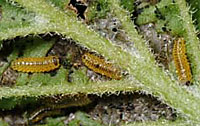Viburnum leaf
beetle home
Logo images by Kent Loeffler, Paul Weston & Craig Cramer
|
Horticultural oil, insecticidal soap work
if your timing is right.
Based on research conducted in 2005, Cornell entomologist Dr. Paul Weston says that two minimally toxic pesticides - insecticidal soap and horticultural oil - may help control viburnum leaf beetles (VLBs) as well as more-toxic, broad-spectrum pesticides. In addition to being safer for homeowners to use, these two pesticides are far less likely to harm beneficial insects that may help keep VLB populations in check.
Weston's studies showed that horticultural oil sprays applied to egg-laying sites might reduce egg hatch by 75 to 80 percent. He also reports that the desiccating effect of insecticidal soap was especially effective against larvae during the 2005 season, which was quite dry during most of the larval development period. It's not clear if insecticidal soap will work as well during a spring with more normal rainfall amounts.
"I don't hesitate to recommend these two products," he says. "The key to make sure they're effective is to time your treatments so they hit the beetles when they're most vulnerable," he says. Both products and application equipment are readily available at garden centers or similar retail outlets.
Horticultural oil is highly refined petroleum oil that is mixed with water and sprayed on infested twigs to coat them and suffocate eggs within the egg-laying sites. It is most effective when used at a high concentration (4%) about 2 to 4 weeks before hatching. Mid-April is usually a good time, notes Weston. But with oil concentrations that high, you need to be sure to spray before the leaves start breaking out of their buds. If you wait too long, you may damage the leaves, he points out. Be particularly careful when applying oil to cranberrybush viburnums (Viburnum opulus) because these plants break bud significantly earlier than arrowwood viburnum (Viburnum dentatum), which breaks bud near the time of viburnum leaf beetle egg hatch.

Use insecticidal soap as soon possible after larvae hatch. Spray the undersides of leaves where larvae feed between veins of young leaves.
Larger image.
More larvae pictures.
|
Insecticidal soap is most effective on larvae soon after they hatch out. Look for ready-to-apply insecticidal soaps or be sure to mix concentrated products precisely to avoid too strong a solution that might damage leaves. Spray infested leaves until the product runs off, paying particular attention to the undersides of leaves where young larvae feed.
"For insecticidal soap to work, you need good contact with the larvae," says Weston. "Young larvae hide in creases around the veins on the underside of emerging leaves, and they're hard to hit unless you're thorough." The nooks and crannies in arrowwood leaves (Viburnum dentatum) make particularly good hiding places.
You may want to delay soap sprays until about a week after hatching, adds Weston. That will give most of the eggs a chance to hatch, and you may be able to get almost all the larvae at once while suffering relatively little leaf damage because the very young larvae don't eat all that much. (The egg hatching period may be a week or even longer when it's cool during hatching.) If you spray right after egg hatch begins, you'll likely have to make another application after the stragglers hatch because the soap has no residual activity. It must contact larvae directly to be effective.
While he has confidence these products can work, Weston would like to hear about your experiences. He wonders, for example, will insecticidal soap work as well during a normal or wet spring as it did during a dry one? If the larvae get ahead of you and you don't use insecticidal soap until they're older, can you still get effective control?
If you try these products this season, please share your experiences and observations with us and your fellow citizen scientists through our online forms. (Online forms no longer available.) (See the management check boxes and comments section near the end of the "Add a viburnum" form.)
For more ways to reduce VLB damage, see Managing viburnum leaf beetles.
© Copyright, Department of Horticulture, Cornell University.
Project coordinator: Lori Brewer, ljb7@cornell.edu
Website design: Craig Cramer cdc25@cornell.edu
Mention of trade names and commercial products is for educational purposes; no discrimination is intended and no endorsement by Cornell Cooperative Extension or Cornell University is implied. Pesticide recommendations are for informational purposes only and manufacturers' recommendations change. Read the manufacturers' instructions carefully before use. Cornell Cooperative Extension and Cornell University assumes no responsibility for the use of any pesticide or chemicals. Some of the links provided are not maintained by Cornell Cooperative Extension and Cornell University. Cornell Cooperative Extension and Cornell University are not responsible for information on these websites. They are included for information purposes only and no endorsement by Cornell Cooperative Extension or Cornell University is implied. Cornell Cooperative Extension provides equal program and employment opportunities.
|